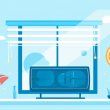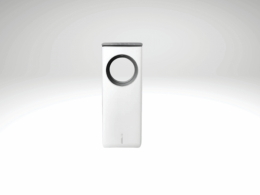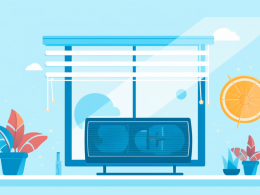As temperatures soar during the hot summer months, staying cool and comfortable becomes a top priority for most people. Portable air conditioners have gained immense popularity in recent years due to their versatility, cost-effectiveness, and convenience. Whether you live in a small apartment or need to cool a specific room, portable air conditioners are an excellent solution to beat the heat without breaking the bank.
In this comprehensive guide, we will walk you through the process of choosing the right portable air conditioner, setting it up, and operating it for maximum efficiency. We will also cover troubleshooting common issues, as well as the proper way to store your unit when not in use. So, let’s dive in and explore the world of portable air conditioners, and how to use a portable air conditioner.
Benefits of using a portable air conditioner
Portable air conditioners have become a popular choice for many households and offices, offering a range of benefits that make them an attractive option for cooling spaces. Here are some of the main advantages of using a portable air conditioner:
Mobility and convenience
One of the most significant benefits of a portable air conditioner is its mobility. These units are designed with caster wheels, allowing you to easily move them from room to room as needed. This flexibility makes them perfect for cooling specific areas or rooms without the need for multiple window units or a central air conditioning system.
Energy efficiency
Portable air conditioners are generally more energy-efficient than traditional window or central air conditioning systems. They allow you to cool only the areas you’re using, reducing overall energy consumption. Additionally, many modern portable air conditioners are designed with energy-saving features, such as programmable thermostats and sleep modes, which help further reduce energy usage and costs.
Cost-effectiveness
In comparison to central air conditioning systems, portable air conditioners are more affordable in terms of both upfront costs and long-term energy bills. They are an ideal option for renters or homeowners who don’t want to invest in a central cooling system or those looking for a supplemental cooling solution to complement their existing setup.
Ideal for small spaces
Portable air conditioners are perfect for small apartments, dorm rooms, or offices where space is limited. They take up minimal floor space and don’t require any permanent installation, making them a convenient option for those with limited room. Plus, their compact size allows for easy storage during the off-season.
In summary, portable air conditioners offer a range of benefits that make them an attractive cooling solution for various situations. Their mobility, energy efficiency, cost-effectiveness, and suitability for small spaces make them a practical and convenient option for staying cool during the hot summer months.
Choosing the right portable air conditioner
Selecting the ideal portable air conditioner for your needs involves considering several factors, including your cooling requirements, desired features, and budget. Here are some essential aspects to take into account when choosing the right portable air conditioner:
Assessing your cooling needs
- Room size: The first step in choosing a portable air conditioner is determining the size of the room you need to cool. Measure the room’s square footage to get a rough idea of the cooling capacity you’ll require. Portable air conditioner capacities are typically measured in BTUs (British Thermal Units) per hour. As a general rule, larger rooms require higher BTU ratings.
- Heat sources: Consider the various heat sources in the room, such as sunlight, appliances, and the number of occupants. Rooms with greater heat loads may require a higher BTU rating to ensure adequate cooling.
Features to consider
- BTU rating: Choose a portable air conditioner with a suitable BTU rating for your room size and heat load. A unit with too low a BTU rating may not cool the space effectively, while an overly powerful unit can lead to higher energy costs and decreased efficiency.
- Noise level: Portable air conditioners can generate noise during operation, which may be disruptive in quiet environments. Look for units with lower decibel (dB) ratings to minimize noise disturbance.
- Energy efficiency: Consider the energy efficiency of the unit, often represented by the Energy Efficiency Ratio (EER) or the Seasonal Energy Efficiency Ratio (SEER). Higher ratings indicate a more energy-efficient air conditioner, which can save you money on energy bills.
- Additional functions: Some portable air conditioners come with extra features, such as air purifiers, dehumidifiers, or heaters, offering added value and versatility. Assess your needs and preferences to determine which additional functions are most relevant to you.
Tips for purchasing
- Online vs. in-store shopping: Compare prices and options both online and in physical stores. Online shopping offers convenience and easy price comparison, while in-store purchases allow you to see and test the unit before buying.
- Reading customer reviews: Customer reviews can provide valuable insights into the performance and reliability of a portable air conditioner. Read reviews to identify any common issues or concerns to make a more informed decision.
- Warranty and return policy: Ensure the portable air conditioner you choose comes with a good warranty and a favorable return policy. A solid warranty can save you money and hassle in the long run if you encounter any issues with your unit.
By carefully considering your cooling needs, desired features, and budget, you can confidently choose the right portable air conditioner to keep your space comfortable and cool during the hot summer months.
Setting up your portable air conditioner
Once you’ve chosen the perfect portable air conditioner for your needs, it’s time to set it up and start enjoying the cool comfort it provides. Here’s a step-by-step guide to setting up your portable air conditioner:
Unpacking and inspecting
Carefully unpack your portable air conditioner and inspect it for any signs of damage or missing parts. Make sure you have all the necessary accessories, such as the exhaust hose, window kit, and remote control, if applicable.
Choosing the best location
- Proximity to a window: Select a location near a window to facilitate easy installation of the exhaust hose and window kit. This will allow the hot air to be vented outside, ensuring optimal cooling performance.
- Airflow and circulation: Place your portable air conditioner in a spot that promotes even air distribution throughout the room. Avoid obstructing the air intake and exhaust vents, and keep the unit away from walls, furniture, and curtains to ensure proper air circulation.
- Accessibility for maintenance: Ensure the location you choose allows easy access for routine maintenance tasks, such as cleaning the filter and emptying the water reservoir if your unit has a built-in dehumidifier.
Installing the window kit
- Types of window kits: Portable air conditioners typically come with window kits designed for standard single-hung, double-hung, or sliding windows. If your unit doesn’t include a suitable window kit for your window type, you may need to purchase an additional adapter or consider alternative venting solutions.
- Step-by-step guide: Follow the manufacturer’s instructions to install the window kit. This usually involves attaching the window bracket to the window frame, adjusting the bracket’s length to fit the window opening, and sealing any gaps with the provided weatherstripping.
Connecting the exhaust hose
Attach one end of the exhaust hose to the air conditioner’s exhaust vent and the other end to the window bracket. Make sure the hose is straight and free of any kinks or bends that may restrict airflow.
Plugging in and powering on
Plug your portable air conditioner into a grounded electrical outlet, ensuring it meets the unit’s power requirements. Turn on the unit using the control panel or remote control and set your desired temperature and fan speed.
By following these steps, you’ll have your portable air conditioner up and running in no time, providing you with a comfortable and cool environment during those hot summer days.
Operating your portable air conditioner

Now that your portable air conditioner is set up, it’s essential to understand how to operate it for optimal performance and efficiency. Here’s a guide to using your portable air conditioner effectively:
Understanding the control panel
- Power button: Use the power button to turn your air conditioner on and off. Some units may also feature a remote control for added convenience.
- Temperature settings: Adjust the temperature settings to your desired comfort level. Most portable air conditioners offer a range of temperature options, typically between 60°F and 90°F (16°C and 32°C).
- Fan speed: Select your preferred fan speed to control the rate at which cool air is circulated throughout the room. Higher fan speeds provide faster cooling but may generate more noise.
- Timer and sleep mode: Use the timer function to program your air conditioner to turn on or off at specific times, helping to conserve energy when you’re not home or during cooler periods. Sleep mode adjusts the temperature and fan speed for a more comfortable sleeping environment while using less energy.
- Additional functions: If your portable air conditioner includes extra features like an air purifier, dehumidifier, or heater, familiarize yourself with their controls and settings to make the most of these added benefits.
Tips for optimal performance
- Regular filter cleaning: Clean the air filter regularly, as per the manufacturer’s recommendations, to ensure proper airflow and maintain your unit’s efficiency. Dirty filters can hinder performance and reduce the air quality in your room.
- Proper air circulation: Keep doors and windows closed while your portable air conditioner is operating to prevent warm air from entering the room and reduce the unit’s cooling efficiency.
- Routine maintenance: Perform routine maintenance tasks, such as emptying the water reservoir if your unit has a built-in dehumidifier, checking for any obstructions in the exhaust hose, and inspecting the unit for any signs of wear or damage.
By familiarizing yourself with the various settings and controls on your portable air conditioner and following these tips for optimal performance, you’ll be able to maintain a comfortable and energy-efficient environment in your space throughout the summer months.
Troubleshooting common issues
Like any appliance, portable air conditioners may occasionally encounter issues during operation. While some problems may require professional assistance, others can be resolved with simple troubleshooting steps. Here are some common issues and their potential solutions:
Air conditioner not turning on
- Check the power connection: Ensure that your air conditioner is securely plugged into a functioning electrical outlet. If necessary, test the outlet with another appliance to confirm it’s working properly.
- Examine the power cord: Inspect the power cord for any visible signs of damage, such as fraying or cuts, which may require replacement.
- Verify the control settings: Confirm that the air conditioner’s control panel settings are correctly configured, including the power button and timer settings.
Insufficient cooling
- Clean the air filter: A dirty air filter can impede airflow and reduce your unit’s cooling efficiency. Clean or replace the filter as per the manufacturer’s recommendations.
- Check the exhaust hose: Ensure that the exhaust hose is properly connected, straight, and free of any obstructions that could hinder airflow.
- Assess the room size and BTU rating: If your air conditioner’s BTU rating is too low for the room size, it may struggle to cool the space effectively. Consider upgrading to a more powerful unit or supplementing with additional cooling solutions.
Strange noises
- Inspect for loose parts: Unusual noises may indicate loose internal components. Turn off your air conditioner and unplug it, then inspect the unit for any loose or vibrating parts that may need tightening or adjustment.
- Evaluate the installation: Ensure that your air conditioner is placed on a flat, stable surface and that the exhaust hose is properly connected and free of kinks or bends.
- Check for debris: Foreign objects, such as debris or small toys, can sometimes enter the air conditioner and cause unusual noises. Carefully inspect the unit and remove any obstructions.
Water leakage
- Empty the water reservoir: If your unit has a built-in dehumidifier, ensure that the water reservoir is emptied regularly to prevent overflow.
- Verify proper installation: Check that the exhaust hose and window kit are correctly installed and the unit is level to avoid water pooling inside the air conditioner.
- Assess the room’s humidity levels: High humidity can cause condensation and water accumulation in your air conditioner. Consider using a separate dehumidifier to reduce humidity levels in the room.
By addressing these common issues through troubleshooting, you can often resolve minor problems and maintain the proper functioning of your portable air conditioner. However, if you encounter persistent or more complex issues, it’s advisable to consult a professional technician for assistance.
Storing your portable air conditioner
As the summer season comes to an end and temperatures begin to drop, it’s time to store your portable air conditioner until the next warm season. Proper storage helps extend the life of your unit and ensures it remains in good working order. Here are some essential steps to follow when storing your portable air conditioner:
Proper cleaning before storage
- Turn off and unplug your air conditioner, allowing it to cool down completely before starting the cleaning process.
- Clean the air filter according to the manufacturer’s instructions. If it’s washable, let it dry thoroughly before reinstalling it.
- Wipe down the exterior of the unit with a damp cloth to remove any dust or dirt, and dry it with a clean, soft cloth.
- Run the air conditioner in the fan-only mode for a few hours to help dry out any remaining moisture inside the unit.
Removing and storing accessories
- Disconnect the exhaust hose and any other accessories, such as the window kit or remote control.
- Clean the exhaust hose by vacuuming any dust or debris, and wipe it down with a damp cloth.
- Carefully coil the exhaust hose and secure it with a cable tie or a piece of string to prevent kinks or damage during storage.
- Store the accessories in a clean, dry place, ideally in a labeled container or bag to keep them organized and protected.
Ideal storage conditions
- Choose a cool, dry, and well-ventilated location to store your portable air conditioner, such as a basement, closet, or garage. Avoid storing it in damp areas or places with extreme temperature fluctuations.
- Keep the unit in an upright position, as laying it on its side may cause damage to the compressor or other internal components.
- Use a protective cover or a large plastic bag to shield your air conditioner from dust, dirt, and moisture. Ensure the cover or bag has ventilation holes to allow air circulation and prevent condensation buildup.
By following these steps to clean, prepare, and store your portable air conditioner properly, you can ensure that it remains in optimal condition and is ready to keep you cool and comfortable when the next warm season arrives.
The Bottom Line
Portable air conditioners have become a popular and convenient solution for maintaining a comfortable living environment during hot summer months. By understanding how to choose the right unit, set it up, operate it effectively, troubleshoot common issues, and store it properly, you can make the most of your portable air conditioner and ensure its longevity.
In this comprehensive guide, we’ve covered the benefits of using a portable air conditioner, selecting the ideal unit, setting it up, operating it for maximum efficiency, troubleshooting potential problems, and properly storing your unit during the off-season.
By following these tips and recommendations, you can stay cool and comfortable while maximizing the performance and lifespan of your portable air conditioner. So, enjoy the refreshing cool air and let your portable air conditioner keep you comfortable throughout the warm seasons to come.










